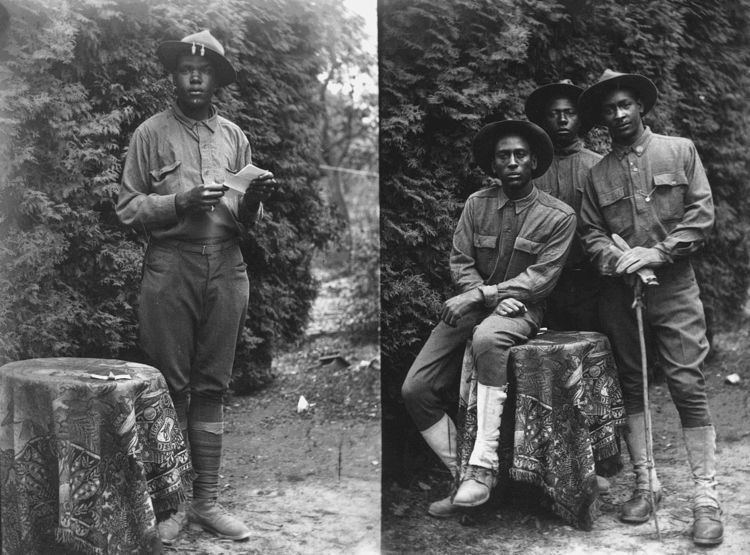 | ||
The 370th Infantry Regiment was the designation for one of the infantry regiments of the 93rd (Provisional) Infantry Division.
Contents
8th Infantry Regiment, Illinois National Guard
This was an all-black operation militia regiment founded in the 1870s.
The Eighth Regiment Armory, located in the Black Metropolis-Bronzeville District of Chicago, Illinois, built in 1914, was the first armory in the United States built for an African-American military regiment.
World War 1
"In World War I the African American 8th Infantry was re-designated the 370th Infantry and fought under the French. It was the only unit entirely commanded by black officers."
"During World War I, as the 370th Infantry, it served with distinction with the French 34th, 36th, and 59th Infantry Divisions, earning streamers for the battles of Lorraine and Oise-Aisne. Sectors occupied and engagements participated in were Saint Mihiel with the French in 1918, Argonne Forest, St. Gobain Forest, Bosi de Mortier, Mont des Signes, Oise-Aisne Canal, Laon, Grandlup, Soissons, and Oise-Aisne and Lorraine offensives. One battalion of the Regiment, under the command of Lieutenant Colonel Otis B. Duncan, was engaged in pursuit of the retreating enemy far in advance, when halted by the Armistice."
The Victory Monument, created by sculptor Leonard Crunelle, was built to honor the service of Eighth Regiment of the Illinois National Guard during World War I. It is located in the Black Metropolis-Bronzeville District in the Douglas community area of Chicago, Illinois.
World War II
The 370th was reactivated in October 1942, along with the rest of the 92nd Division, ten months after the American entry into World War II. After nearly two years of training, it departed the United States in July 1944 and arrived on the Italian Front, landing at Naples on 1 August, attached to the Task Force 42 of the 1st Armored Division. The 370th entered combat on 24 August 1944 as part of the U.S. Fifth Army. It participated in the crossing of the Arno River, the occupation of Lucca and the penetration of the Gothic Line, in the persuit of an enemy which was retreating from that area. It was later attached to the 92nd Division in Task Force 45, the Fifth Army unit responsible for the Ligurian coastal sector, the left flank of Allied troops in Italy. On 13 October, the remainder of the 92nd Division concentrated for patrol activities. Elements of the 92nd Division moved to the Serchio sector, 3 November, and advanced in the Serchio River Valley against light resistance, but the attempt to capture Castelnuovo did not succeed. Patrol activities continued until 26 December when the enemy attacked (Winter Line), forcing units of the 92nd Division to withdraw. The attack ended on 28 December. The attacking forces were mainly from the Alpine Division "Monte Rosa", a division of the Italian Fascist Army (4 battalions) with the support of 3 German battalions. Aside from patrols and reconnaissance, units of the 92nd attacked in the Serchio sector, 5-8 February 1945, against the Italian Bersaglieri Division "Italia", another unit of the army of the Italian Social Republic, but enemy counterattacks nullified division advances.
On 1 April, the 370th RCT and the attached 442nd Infantry (Nisei) attacked in the Ligurian coastal sector and drove rapidly north against light opposition of German 148th Infantry Division supported by Italian coastal units. The 370th took over the Serchio sector and pursued a retreating enemy from 18 April until the collapse of enemy forces, 29 April 1945. Elements of the 92nd Division entered La Spezia and Genoa on 27 April and took over selected towns along the Ligurian coast until the enemy surrendered, 2 May 1945. Between August 1944 and May 1945 the 92nd Division suffered 3,200 casualties, factoring losses from units attached to the Division brings the totals up to 5,000 casualties.
On the Italian Front, the Buffalo soldiers had an opportunity to make contact with men of many nationalities: beyond other segregated Americans like the Japanese descendants, they had contact with the also segregated troops of British and French colonial empires (Black Africans, Moroccans, Algerians, Indians, Gurkhas, Jews and Palestinians) as well as with exiled Poles, Greeks and Czechs; anti-fascist Italians and the non-segregated troops of the Brazilian Expeditionary Force.
